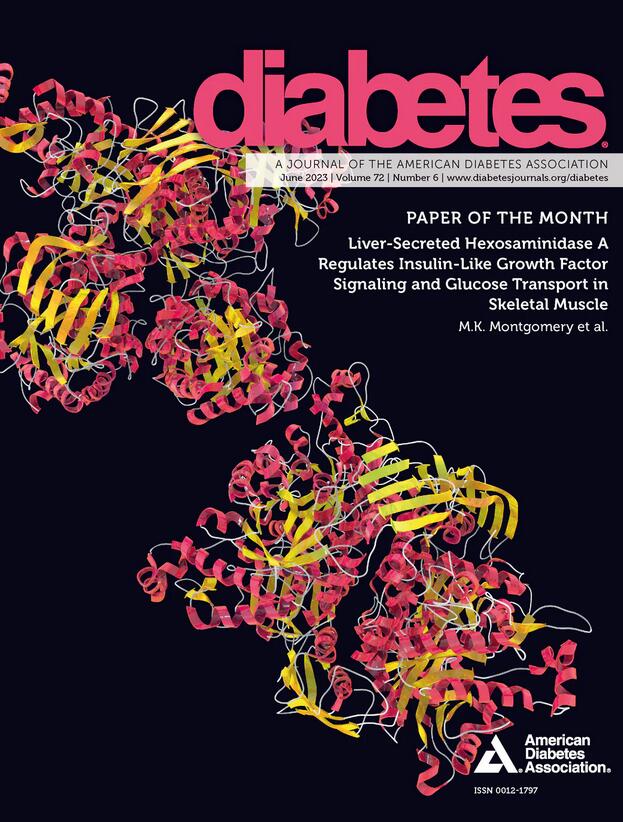345-OR: 大小无关--胰腺体积和胰腺脂肪对 2 型糖尿病的影响
IF 6.2
1区 医学
Q1 ENDOCRINOLOGY & METABOLISM
引用次数: 0
摘要
引言& 目的:人们认为2型糖尿病(T2D)患者的胰腺体积较小;然而,这究竟是T2D的原因还是结果尚不清楚。我们研究了胰腺体积与 T2D 风险之间的关系,以及这种关系是否会因胰腺脂肪而改变。研究方法利用英国生物库的磁共振成像,根据胰腺体积(60 立方厘米)和胰腺脂肪(8%)的中位值将 25,389 人分为四组。我们使用逻辑回归法估算了T2D发病率的比值比(ORs)。此外,我们还在一个独立的日本队列中开展了一项为期 6 年的病例队列研究,在健康检查期间使用了计算机断层扫描技术。我们使用加权-Cox 回归估算了 658 名随机抽取的患者和 2,168 名未患糖尿病的患者中 146 个 T2D 发病病例的危险比(HRs)。这两项研究的回归模型都对年龄、性别、体重指数、每日酒精摄入量、当前吸烟情况、肝脏脂肪和内脏脂肪进行了调整。研究结果在英国生物库中,胰腺脂肪堆积较少的人患 T2D 的可能性最高。与大/低脂肪胰腺相比,小/高脂肪胰腺的 T2D 调整 ORs(95%CI)为 1.63(1.36-1.97),大/高脂肪胰腺为 1.09(0.89-1.33),小/低脂肪胰腺为 1.08(0.85-1.37)。这一发现在中位随访 6.27 年的日本队列中得到了前瞻性验证。调整后的 T2D 发生率(95%CI)为:小/高脂胰腺为 3.12(1.40-6.96),大/高脂胰腺为 1.00(0.59-1.69),小/低脂胰腺为 0.74(0.26-2.14)。结论脂肪在已经较小的胰腺中堆积似乎是导致 T2D 风险升高的关键因素,因此可能成为预防干预的新目标。披露 H. Yamazaki:其他关系;阿斯利康、杨森制药公司、三菱田边制药株式会社、Kowa Company, Ltd.、Kyorin Pharmaceutical Co.S. Tauchi:无。M. Dohke:无:M. Dohke:无。N. Hanawa: None.Y. Kodama:无。A. Katanuma:无。S. Fukuhara:S. Fukuhara: None.K. Prystupa:无。J. Hummel:无。R. Wagner:Speaker's Bureau; Sanofi.顾问团;礼来糖尿病。Speaker's Bureau; Boehringer-Ingelheim, Novo Nordisk.M. Heni:研究支持;Boehringer-Ingelheim。顾问团;Amryt Pharma Plc.Speaker's Bureau; Amryt Pharma Plc.Advisory Panel; Boehringer-Ingelheim, Boehringer-Ingelheim.演讲人办公室;礼来糖尿病公司、诺华股份公司、诺和诺德公司、赛诺菲公司。基金资助 日本科学振兴会 KAKENHI 基金 (JP22K15685);德国研究基金会 (DFG,德国研究基金会:518749683)本文章由计算机程序翻译,如有差异,请以英文原文为准。
345-OR: Beyond Size Matters—The Impact of Pancreatic Volume and Pancreatic Fat on Type 2 Diabetes
Introduction & Objective: Individuals with type 2 diabetes (T2D) are thought to have a smaller pancreas; however, whether this is cause or consequence of T2D is unclear. We investigated the association between pancreas volume and T2D risk and whether this association was modified by pancreatic fat. Methods: Using magnetic resonance imaging from the UK Biobank, 25,389 individuals were classified into four groups based on the median values of pancreas volume (60 cm3) and pancreatic fat (8%). Odds ratios (ORs) for prevalent T2D were estimated using logistic regression. Additionally, we conducted a 6-year case-cohort study in an independent Japanese cohort using computed tomography during health examinations. Hazard ratios (HRs) for incident T2D were estimated using weighted-Cox regression in 658 randomly-selected individuals and 146 incident T2D cases among 2,168 individuals without diabetes. The regression models in both studies were adjusted for age, sex, body mass index, daily alcohol intake, current smoking, liver fat, and visceral fat. Results: In the UK Biobank, individuals who had fat accumulation in a smaller pancreas exhibited the highest likelihood of T2D. Compared with large/low-fat pancreas, the adjusted ORs (95%CI) of T2D were 1.63 (1.36-1.97) in small/high-fat pancreas, 1.09 (0.89-1.33) in large/high-fat pancreas, and 1.08 (0.85-1.37) in small/low-fat pancreas. This finding was prospectively validated in the Japanese cohort with 6.27-year median follow-up. The adjusted HRs (95%CI) of incident T2D were 3.12 (1.40-6.96) in small/high-fat pancreas, 1.00 (0.59-1.69) in large/high-fat pancreas, and 0.74 (0.26-2.14) in small/low-fat pancreas. Conclusion: Fat accumulation in an already smaller pancreas appears to be a key determinant of elevated T2D risk and might therefore be a novel target for preventive interventions. Disclosure H. Yamazaki: Other Relationship; AstraZeneca, Janssen Pharmaceuticals, Inc., Mitsubishi Tanabe Pharma Corporation, Kowa Company, Ltd., Kyorin Pharmaceutical Co. Ltd, Takeda Pharmaceutical Company Limited, Takeda Pharmaceutical Company Limited, Magmitt Pharmaceutical Co. S. Tauchi: None. M. Dohke: None. N. Hanawa: None. Y. Kodama: None. A. Katanuma: None. S. Fukuhara: None. K. Prystupa: None. J. Hummel: None. R. Wagner: Speaker's Bureau; Sanofi. Advisory Panel; Lilly Diabetes. Speaker's Bureau; Boehringer-Ingelheim, Novo Nordisk. M. Heni: Research Support; Boehringer-Ingelheim. Advisory Panel; Amryt Pharma Plc. Speaker's Bureau; Amryt Pharma Plc. Advisory Panel; Boehringer-Ingelheim, Boehringer-Ingelheim. Speaker's Bureau; Lilly Diabetes, Novartis AG, Novo Nordisk, Sanofi. Funding Japan Society for the Promotion of Science KAKENHI grants (JP22K15685); Deutsche Forschungsgemeinschaft (DFG, German Research Foundation: 518749683)
求助全文
通过发布文献求助,成功后即可免费获取论文全文。
去求助
来源期刊

Diabetes
医学-内分泌学与代谢
CiteScore
12.50
自引率
2.60%
发文量
1968
审稿时长
1 months
期刊介绍:
Diabetes is a scientific journal that publishes original research exploring the physiological and pathophysiological aspects of diabetes mellitus. We encourage submissions of manuscripts pertaining to laboratory, animal, or human research, covering a wide range of topics. Our primary focus is on investigative reports investigating various aspects such as the development and progression of diabetes, along with its associated complications. We also welcome studies delving into normal and pathological pancreatic islet function and intermediary metabolism, as well as exploring the mechanisms of drug and hormone action from a pharmacological perspective. Additionally, we encourage submissions that delve into the biochemical and molecular aspects of both normal and abnormal biological processes.
However, it is important to note that we do not publish studies relating to diabetes education or the application of accepted therapeutic and diagnostic approaches to patients with diabetes mellitus. Our aim is to provide a platform for research that contributes to advancing our understanding of the underlying mechanisms and processes of diabetes.
 求助内容:
求助内容: 应助结果提醒方式:
应助结果提醒方式:


